Search results for "stackypi OR raspberry OR pi OR rp2040 OR based OR board"
-
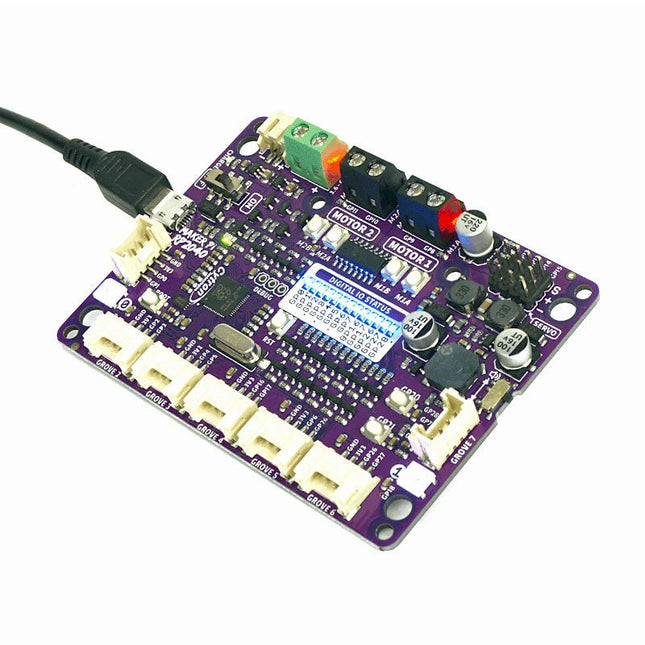
Cytron Cytron Maker Pi RP2040 - Robotics with Raspberry Pi RP2040
Cytron Maker Pi RP2040 features the first microcontroller designed by Raspberry Pi – RP2040, embedded on a robot controller board. This board comes with dual channel DC motor driver, 4 servo motor ports and 7 Grove I/O connectors, ready for your next DIY robot / motion control project. Now you can build robot, while trying out the new RP2040 chip. The DC motor driver onboard is able to control 2x brushed DC motors or 1x bipolar/unipolar stepper motor rated from 3.6 V to 6 V, providing up to 1 A current per channel continuously. The built-in Quick Test buttons and motor output LEDs allow functional test of the motor driver in a quick and convenient way, without the need of writing any code. Vmotor for both DC and servo motors depends on the input voltage supplied to the board. Maker Pi RP2040 features all the goodness of Cytron's Maker series products. It too has lots of LEDs useful for troubleshooting (& visual effects), is able to make quite some noise with the onboard piezo buzzer and comes with push buttons ready to detect your touch. There are three ways to supply power to the Maker Pi RP2040 – via USB (5 V) socket, with a single cell LiPo/Li-Ion battery or through the VIN (3.6-6 V) terminals. However only one power source is needed to power up both controller board and motors at a time. Power supply from all these power sources can all be controlled with the power on/off switch onboard. Cytron Maker Pi RP2040 is basically the Raspberry Pi Pico + Maker series' goodness + Robot controller & other useful features. Therefore this board is compatible with the existing Pico ecosystem. Software, firmware, libraries and resources that are developed for Pico should work seamlessly with Cytron Maker Pi RP2040 too. CircuitPython is preloaded on the Maker Pi RP2040 and it runs a simple demo program right out-of-the-box. Connect it to your computer via USB micro cable and turn it on, you will be greeted by a melody tune and LEDs running light. Press GP20 and GP21 push buttons to toggle the LEDs on/off, while controlling any DC and servo motors connected to it to move and stop. With this demo code, you get to test the board the moment you receive it! While connected to your computer, a new CIRCUITPY drive appears. Explore and edit the demo code (code.py & lib folder) with any code editor you like, save any changes to the drive and you shall see it in action in no time. That's why we embrace CircuitPython – it's very easy to get started. Wish to use other programming lauguages? Sure, you are free to use MicroPython and C/C++ for Pico/RP2040. For those of you who loves the Arduino ecosystem, please take a look at this official news by Arduino and also the unofficial Pico Arduino Core by Earle F. Philhower. Features Powered by Rapberry Pi RP2040 Dual-core Arm Cortex-M0+ processor 264 KB internal RAM 2 MB of Flash memory the exact same specifications with Raspberry Pi Pico Robot controller board 4x Servo motors 2x DC motors with quick test buttons Versatile power circuit Automatic power selection: USB 5 V, LiPo (1-cell) or Vin (3.6-6 V) Built-in 1-cell LiPo/Li-Ion charger (over-charged & over-discharged protection) Power on/off switch 13x Status indicator LEDs for GPIO pins 1x Piezo buzzer with mute switch 2x Push button 2x RGB LED (Neopixel) 7x Grove ports (flexible I/O options: digital, analog, I²C, SPI, UART...) Preloaded with CircuitPython by default Mouting holes 4x 4.8 mm mounting hole (LEGO pin compatible) 6x M3 screw hole
€ 16,95
Members € 15,26
-
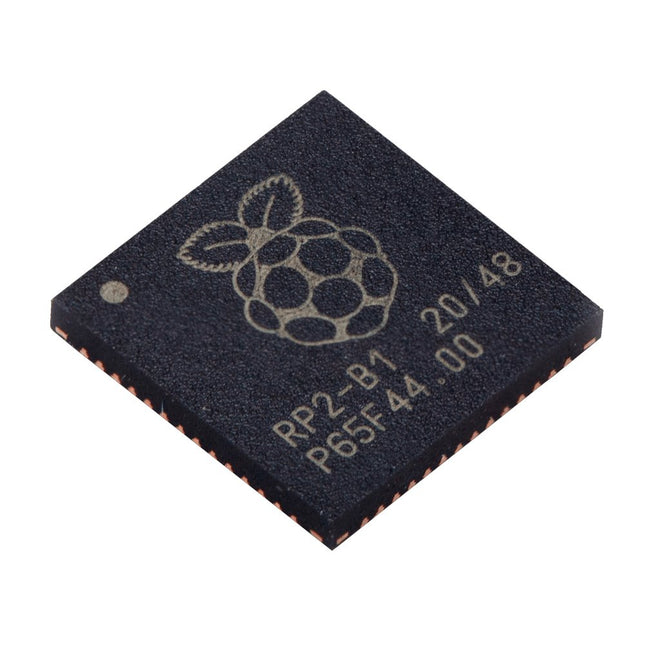
Raspberry Pi Foundation Raspberry Pi RP2040 Microcontroller (10 pcs)
Technical Specifications Dual ARM Cortex-M0+ @ 133 MHz 264 kB on-chip SRAM in six independent banks Support for up to 16 MB of off-chip Flash memory via dedicated QSPI bus DMA controller Fully-connected AHB crossbar Interpolator and integer divider peripherals On-chip programmable LDO to generate core voltage 2x on-chip PLLs to generate USB and core clocks 30x GPIO pins, 4 of which can be used as analogue inputs Peripherals 2x UARTs 2x SPI controllers 2x I²C controllers 16x PWM channels USB 1.1 controller and PHY, with host and device support 8x PIO state machines What you'll get 10x bare RP2040 chips
€ 7,95
Members identical
-
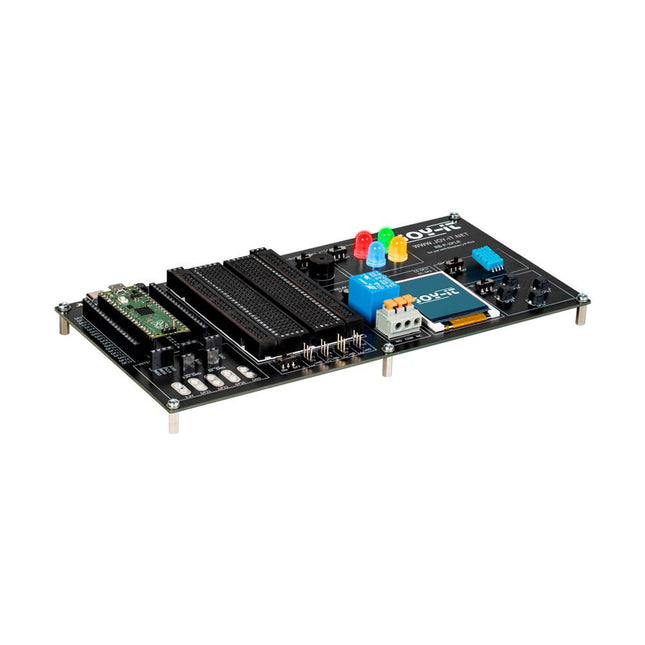
JOY-iT JOY-iT Explorer Board for Raspberry Pi Pico
The Explorer Board is the easy and efficient way to develop your Raspberry Pi Pico projects. Since the most important components are already integrated, you save time and effort on wiring. The Explorer Board has a wide range of interface connectors so you can connect your projects to a variety of modules and devices. With the integrated breadboard, you can quickly build and realize your own projects. Thanks to the possibility to connect or disconnect all modules individually, you can use your pins, which are additionally led separately to the outside, for other projects or experiment on the integrated breadboard at any time. Features Fast and efficient experimenting with the Raspberry Pi Pico Raspberry Pi Pico can be plugged in directly All modules can be switched on and off individually Additional integrated breadboard for own development Specifications Integrated modules: 4 RGB LEDs, buzzer, relay, 1.8“ TFT display, DHT11 temperature sensor, 4 buttons, breadboard Interfaces: 4x servo motor, SPI, I²C, UART, 5x crocodile clip connector Power supply: 5 V USB-C Dimensions: 219 x 110 x 27 mm Downloads Manual Examples and libraries
€ 27,95
Members € 25,16
-
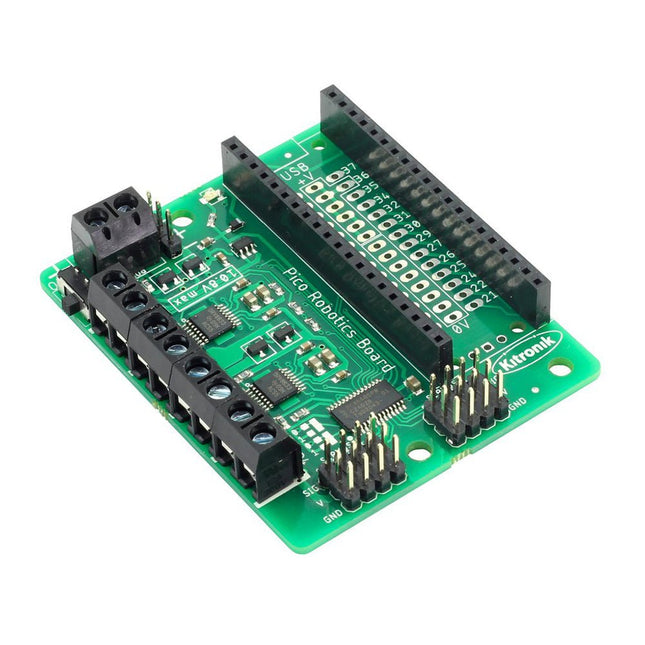
Kitronik Kitronik Robotics Board for Raspberry Pi Pico
The Robotics Board features 2 Dual H Bridge Motor Driver ICs. These are capable of driving 2 standard motors or 1 stepper motor each, with full forward, reverse, and stop control. There are also 8 servo outputs, capable of driving standard and continuous rotation servos. They can all be controlled by the Pico using the I²C protocol, via a 16 channel driver IC. The IO break out provides connections to all the unused pins on the Pico. The 27 available I/O pins allow other devices, such as sensors or ZIP LEDs, to be added to the board. Power is provided via either a terminal block or servo style connector. The supply is then controlled by an on/off power switch to the board and there is also a green LED to indicate when the board has power. The board then produces a regulated 3.3V supply which is fed into the 3 V and GND connections to power the connected Pico. This removes the need to power the Pico separately. The 3 V and GND pins are also broken out on the header, which means external devices can also be powered. To use the robotics board, the Pico should be firmly inserted into the dual row pin socket on the board. Ensure the Pico is inserted with the USB connector at the same end as the power connectors on the robotics board. This will allow access to all of the board functions and each pin is broken out. Features A compact yet feature-packed board designed to sit at the heart of your Raspberry Pi Pico robotics projects. The board can drive 4 motors (or 2 stepper motors) and 8 servos, with full forward, reverse, and stop control. It also features 27 other I/O expansion points and Power and Ground connections. The I²C communication lines are also broken out allowing other I²C compatible devices to be controlled. This board also features an on/off switch and power status LED. Power the board via either a terminal block or servo style connector. The 3V and GND pins are also broken out on the Link header, allowing external devices to be powered. Code it with MicroPython or via an editor such as the Thonny editor. 1 x Kitronik Compact Robotics Board for Raspberry Pi Pico Dimensions: 68 x 56 x 10 mm Requires Raspberry Pi Pico board
€ 24,95
Members € 22,46
-

SB Components ArdiPi Uno R3 Board (based on Raspberry Pi Pico W)
ArdiPi is the ultimate Arduino Uno alternative packed with powerful specs and exciting features in the Arduino Uno form factor. You can enjoy a low-cost solution with access to the largest support communities for Raspberry Pi. ArdiPi variant is powered by Raspberry Pi Pico W. The built-in Wi-Fi and Bluetooth connectivity makes the board ideal for IoT projects or projects requiring wireless communication. Features Arduino Uno form factor, so you can connect 3.3 V compatible Arduino shields SD card slot for storage and data transfer Drag-and-drop programming using mass storage over USB Multifunction GPIO breakout supporting general I/O, UART, I²C, SPI, ADC & PWM functions. Multi-tune Buzzer to add audio alert into the project SWD pins breakout for serial debugging Multi-platform support like Arduino IDE, MicroPython, and CircuitPython. Comes with HID support, so the device can simulate a mouse or keyboard Specifications Powered by RP2040 microcontroller which is a dual-core Arm Cortex-M0+ processor, 2 MB of onboard flash storage, 264 kB of RAM On-board single-band 2.4 GHz wireless interfaces (802.11n) for WiFi and Bluetooth 5 (LE) WPA3 & Soft access point supporting up to four clients Operating voltage of pins 3.3 V and board supply 5 V 25 Multipurpose GPIOs breakout in Arduino style for easy peripheral interfacing I²C, SPI, and UART communications protocol support 2 MB of onboard Flash memory Cross-platform development and multiple programming language support
€ 24,95
Members € 22,46
-
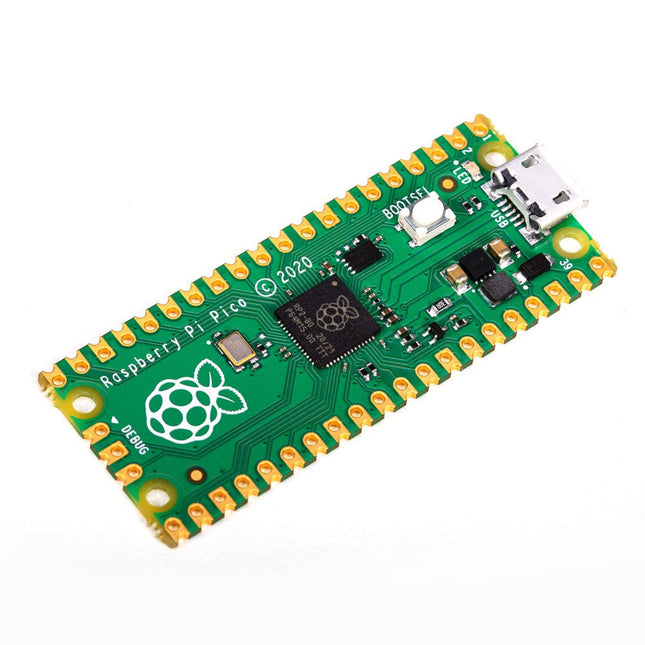
Raspberry Pi Foundation Raspberry Pi Pico
Specifications RP2040 microcontroller chip designed by Raspberry Pi in the UK Dual-core ARM Cortex M0+ processor, with a flexible clock running up to 133 MHz 264 kB SRAM, and 2 MB on-board Flash memory Castellated module allows soldering directly to carrier boards USB 1.1 host and device support Energy-efficient sleep and dormant modes Drag and drop programming using mass storage via USB 26x multifunction GPIO pins 2x SPI, 2x I²C, 2x UART, 3x 12-bit ADC, 16x controllable PWM channels On-chip accurate clock and timer Temperature sensor On-chip accelerated floating point libraries 8x programmable IO (PIO) state machines for custom peripherals Why a Raspberry Pi Pico? Designing your own microcontroller instead of buying an existing one brings a number of advantages. According to Raspberry Pi itself, not one of the existing products available for this comes close to their price/performance ratio. This Raspberry Pi Pico has also given Raspberry Pi the ability to add some innovative and powerful features of their own. These features are not available anywhere else. A third reason is that the Raspberry Pi Pico has given Raspberry Pi the ability to create powerful software around the product. Surrounding this software stack is an extensive documentation set. The software and documentation meet the high standard of Raspberry Pi's core products (such as the Raspberry Pi 400, Pi 4 Model B and Pi 3 Model A+). Who is this microcontroller for? The Raspberry Pi Pico is suitable for both advanced and novice users. From controlling a display to controlling many different devices that you use every day. Automating everyday operations is made possible by this technology. Beginner users The Raspberry Pi Pico is programmable in the C and MicroPython languages and is customizable for a wide range of devices. In addition, the Pico is as easy to use as dragging and dropping files. This makes this microcontroller ideally suited for the novice user. Advanced users For advanced users, it is possible to take advantage of the Pico's extensive peripherals. The peripherals include the SPI, I²C, and eight programmable I/O (PIO)-state machines. What makes the Raspberry Pi Pico unique? What's unique about the Pico is that it was developed by Raspberry Pi itself. The RP2040 features a dual-core Arm Cortex-M0+ processor with 264 KB of internal RAM and support for up to 16 MB of off-chip Flash. The Raspberry Pi Pico is unique for several reasons: The product has the highest price/quality ratio in the microcontroller board market. The Raspberry Pi Pico has been developed by Raspberry Pi itself. The software stack surrounding this product is of high quality and comes paired with a comprehensive documentation set.
€ 4,95
Members identical
-
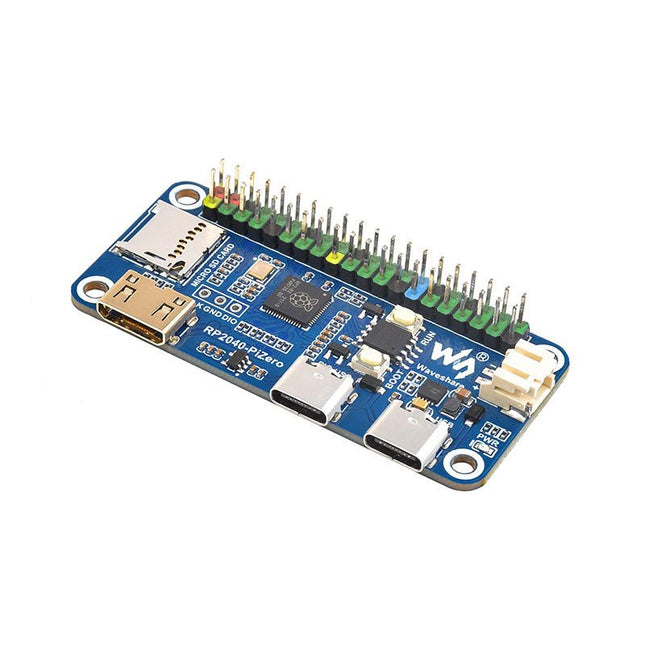
Waveshare Waveshare RP2040-PiZero Development Board
Waveshare RP2040-PiZero is a high-performance and cost-effective microcontroller board with onboard DVI interface, TF card slot and PIO-USB port, compatible with Raspberry Pi 40-pin GPIO header, easy to develop and integrate into the products. Features RP2040 microcontroller chip designed by Raspberry Pi Dual-core ARM Cortex M0+ processor, flexible clock running up to 133 MHz 264 KB of SRAM, and 16 MB of onboard Flash memory Onboard DVI interface can drive most HDMI screens (DVI compatibility required) Supports using as a USB host or slave via onboard PIO-USB port Onboard TF card slot for reading and writing TF card Onboard Lithium battery recharge/discharge header, suitable for mobile scenarios USB 1.1 with device and host support Drag-and-drop programming using mass storage over USB Low-power sleep and dormant modes 2x SPI, 2x I²C, 2x UART, 4x 12-bit ADC, 16x controllable PWM channels Accurate clock and timer on-chip Temperature sensor Accelerated floating-point libraries on-chip Downloads Wiki
€ 17,95
Members € 16,16
-

Elektor Publishing Multitasking with Raspberry Pi
Multitasking and multiprocessing have become a very important topic in microcontroller-based systems, namely in complex commercial, domestic, and industrial automation applications. As the complexity of projects grows, more functionalities are demanded from the projects. Such projects require the use of multiple inter-related tasks running on the same system and sharing the available resources, such as the CPU, memory, and input-output ports. As a result of this, the importance of multitasking operations in microcontroller-based applications has grown steadily over the last few years. Many complex automation projects now make use of some form of a multitasking kernel. This book is project-based and its main aim is to teach the basic features of multitasking using the Python 3 programming language on Raspberry Pi. Many fully tested projects are provided in the book using the multitasking modules of Python. Each project is described fully and in detail. Complete program listings are given for each project. Readers should be able to use the projects as they are, or modify them to suit their own needs. The following Python multitasking modules have been described and used in the projects: Fork Thread Threading Subprocess Multiprocessing The book includes simple multitasking projects such as independently controlling multiple LEDs, to more complex multitasking projects such as on/off temperature control, traffic lights control, 2-digit, and 4-digit 7-segment LED event counter, reaction timer, stepper motor control, keypad based projects, car park controller, and many more. The fundamental multitasking concepts such as process synchronization, process communication, and memory sharing techniques have been described in projects concerning event flags, queues, semaphores, values, and so on.
€ 39,95
Members € 35,96
-
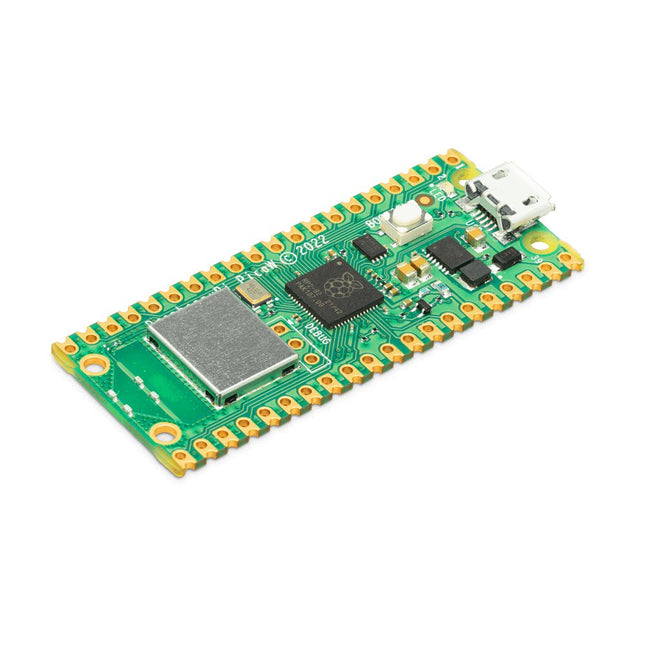
Raspberry Pi Foundation Raspberry Pi Pico W
Raspberry Pi Pico W is a microcontroller board based on the Raspberry Pi RP2040 microcontroller chip. The RP2040 microcontroller chip ('Raspberry Silicon') offers a dual-core ARM Cortex-M0+ processor (133 MHz), 256 KB RAM, 30 GPIO pins, and many other interface options. In addition, there is 2 MB of on-board QSPI flash memory for code and data storage. Raspberry Pi Pico W has been designed to be a low cost yet flexible development platform for RP2040 with a 2.4 GHz wireless interface using an Infineon CYW43439. The wireless interface is connected via SPI to the RP2040. Features of Pico W RP2040 microcontroller with 2 MB of flash memory On-board single-band 2.4 GHz wireless interfaces (802.11n) Micro USB B port for power and data (and for reprogramming the flash) 40 pin 21 x 51 mm 'DIP' style 1 mm thick PCB with 0.1' through-hole pins also with edge castellations Exposes 26 multi-function 3.3 V general purpose I/O (GPIO) 23 GPIO are digital-only, with three also being ADC capable Can be surface mounted as a module 3-pin ARM serial wire debug (SWD) port Simple yet highly flexible power supply architecture Various options for easily powering the unit from micro USB, external supplies or batteries High quality, low cost, high availability Comprehensive SDK, software examples and documentation Features of the RP2040 microcontroller Dual-core cortex M0+ at up to 133 MHz On-chip PLL allows variable core frequency 264 kByte multi-bank high performance SRAM External Quad-SPI Flash with eXecute In Place (XIP) and 16 kByte on-chip cache High performance full-crossbar bus fabric On-board USB1.1 (device or host) 30 multi-function general purpose I/O (four can be used for ADC) 1.8-3.3 V I/O voltage 12-bit 500 ksps analogue to digital converter (ADC) Various digital peripherals 2x UART, 2x I²C, 2x SPI, 16x PWM channels 1x timer with 4 alarms, 1x real time clock 2x programmable I/O (PIO) blocks, 8 state machines in total Flexible, user-programmable high-speed I/O Can emulate interfaces such as SD card and VGA Note: Raspberry Pi Pico W I/O voltage is fixed at 3.3 V. Downloads Datasheet Specifications of 3-pin Debug Connector
€ 7,95
Members identical
-

Pimoroni Pimoroni Raspberry Pi Pico Explorer Base
We've incorporated tinkering essentials like a mini breadboard, motor drivers, ADC inputs, a built in speaker, general purpose inputs/outputs, switches, and two Breakout Garden slots so you can add on a couple of breakouts. We've also managed to fit in a vibrant 240x240 IPS LCD screen with four tactile buttons so you can easily monitor and control what your project is doing. It's all wrapped up in a nice, sturdy baseboard with a pleasingly compact footprint which won't involve nearly as many trailing wires as if you were experimenting with a traditional breadboard setup. Our comprehensive MicroPython and C++ libraries will let you control every aspect of the board like a digital maestro. It's great for beginners and advanced users. Features Pico Explorer Base Piezo speaker 1.54' IPS LCD screen (240x240) Four user-controllable switches Two Half-Bridge motor drivers (with over current indicator LED) Easy access GPIO and ADC pin Headers Two Breakout Garden I²C sockets Mini breadboard Rubber feet Compatible with Raspberry Pi Pico No soldering required (as long as your Pico has header pins attached). Dimensions: approx 117 x 63 x 20 mm (L x W x H, assembled) C/C++ and MicroPython libraries Schematic
€ 29,95
Members € 26,96
-
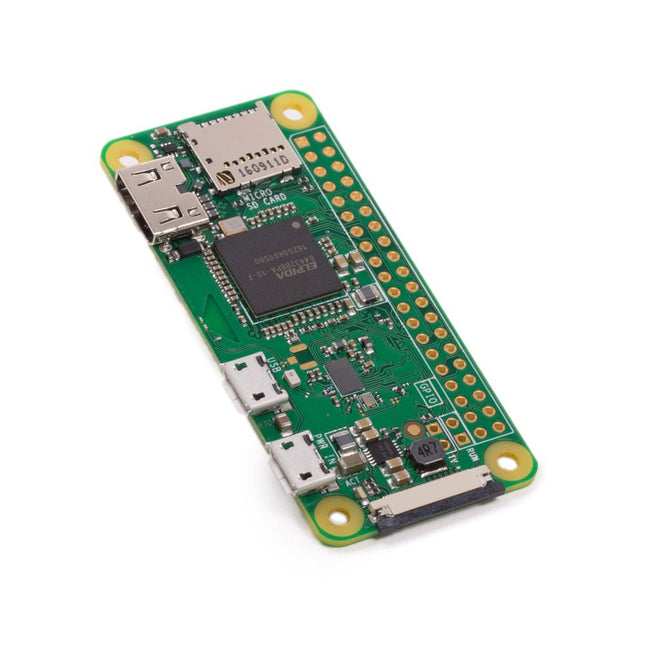
Raspberry Pi Foundation Raspberry Pi Zero W
The Raspberry Pi Zero W extends the Raspberry Pi Zero family. The Raspberry Pi Zero W has all the functionality of the original Raspberry Pi Zero, but comes with added connectivity consisting of: 802.11 b/g/n wireless LAN Bluetooth 4.1 Bluetooth Low Energy (BLE) Other Features 1 GHz, single-core CPU 512 MB RAM Mini HDMI and USB On-The-Go ports Micro-USB power HAT-compatible 40-pin header Composite video and reset headers CSI camera connector Downloads Mechanical Drawing Schematics
€ 17,95
Members identical
-

SparkFun SparkFun RP2040 mikroBUS Development Board
The SparkFun RP2040 mikroBUS Development Board is a low-cost, high performance platform with flexible digital interfaces featuring the Raspberry Pi Foundation's RP2040 microcontroller. Besides the Thing Plus or Feather PTH pin layout, the board also includes a microSD card slot, 16 MB (128 Mbit) flash memory, a JST single cell battery connector (with a charging circuit and fuel gauge sensor), an addressable WS2812 RGB LED, JTAG PTH pins, four (4-40 screw) mounting holes, our signature Qwiic connectors, and a mikroBUS socket. The mikroBUS standard was developed by MikroElektronika. Similar to Qwiic and MicroMod interfaces, the mikroBUS socket provides a standardized connection for add-on Click boards to be attached to a development board and is comprised of a pair of 8-pin female headers with a standardized pin configuration. The pins consist of three groups of communications pins (SPI, UART and I²C), six additional pins (PWM, Interrupt, Analog input, Reset and Chip select), and two power groups (3.3 V and 5 V). The RP2040 is supported with both C/C++ and MicroPython cross-platform development environments, including easy access to runtime debugging. It has UF2 boot and floating-point routines baked into the chip. While the chip has a large amount of internal RAM, the board includes an additional 16 MB of external QSPI flash memory to store program code. The RP2040 contains two ARM Cortex-M0+ processors (up to 133 MHz) and features: 264 kB of embedded SRAM in six banks 6 dedicated IO for SPI Flash (supporting XIP) 30 multifunction GPIO: Dedicated hardware for commonly used peripherals Programmable IO for extended peripheral support Four 12-bit ADC channels with internal temperature sensor (up to 0.5 MSa/s) USB 1.1 Host/Device functionality Features (SparkFun RP2040 mikroBUS Dev. Board) Raspberry Pi Foundation's RP2040 microcontroller 18 Multifunctional GPIO Pins Four available 12-bit ADC channels with internal temperature sensor (500kSa/s) Up to eight 2-channel PWM Up to two UARTs Up to two I²C buses Up to two SPI buses Thing Plus (or Feather) Pin Layout: 28 PTH Pins USB-C Connector: USB 1.1 Host/Device functionality 2-pin JST Connector for a LiPo Battery (not included): 500mA charging circuit 4-pin JST Qwiic Connector LEDs: PWR - Red 3.3V power indicator CHG - Yellow battery charging indicator 25 - Blue status/test LED (GPIO 25) WS2812 - Addressable RGB LED (GPIO 08) Buttons: Boot Reset JTAG PTH Pins 16MB QSPI Flash Memory µSD Card Slot mikroBUS Socket Dimensions: 3.7' x 1.2' Four Mounting Holes: 4-40 screw compatible Downloads Schematic Eagle Files Board Dimensions Hookup Guide Qwiic Info Page GitHub Hardware Repository
€ 19,95
Members € 17,96











